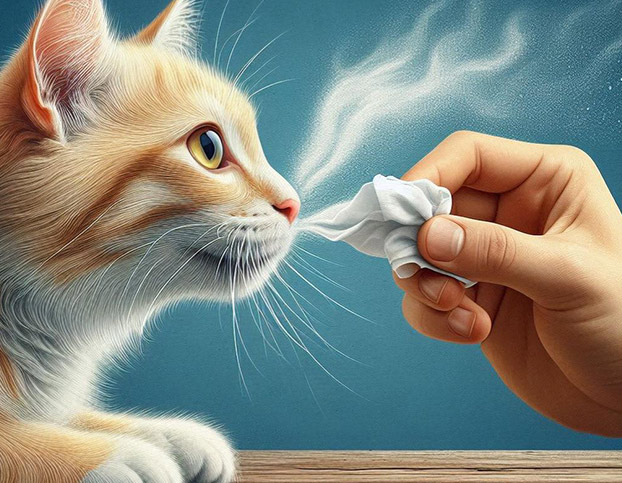As a devoted cat owner, you’re likely familiar with the occasional sneeze or a bit of nasal discharge from your feline friend. While sometimes it might seem like a harmless cold, it’s important to understand that persistent or unusual nasal symptoms in cats can indicate more than just a minor sniffle. Feline nasal disease, also known as rhinitis, is a common issue in our feline companions, and recognizing the signs and potential underlying causes is crucial for their well-being.
What Exactly is Rhinitis?
Simply put, rhinitis is the inflammation of the lining your cat’s nasal cavity. Just like in humans, this inflammation can lead to a variety of uncomfortable symptoms. Rhinitis can be either acute (sudden onset) or chronic (long-lasting or recurring).
Rhinitis can be either acute or chronic
More Than Just a Cold: Potential Causes of Feline Rhinitis
It’s easy to dismiss a bit of sneezing as a cold or allergies, but in cats, the reasons behind nasal inflammation are usually more complicated. Here are some of the potential culprits:
- Dental Issues: Surprisingly, problems in your cat’s mouth, such as tooth root infection, oronasal fistulas (abnormal openings between the mouth and nose), and severe dental disease, can lead to nasal inflammation. The close proximity of the upper teeth roots to the nasal cavity is the reason.
- Viral Infections: Just like us, cats can get viral infections that affect their upper respiratory tract. Feline Herpesvirus-1 (FHV-1) and Feline Calicivirus are common culprits. These can be long-lasting and result in chronic (months, even years) symptoms.
- Fungal Infections: Certain fungal organisms such as Cryptococcus can infect the nasal passages, leading to rhinitis, sneezing and a runny nose. If left untreated, nasal (facial) deformity can occur as the fungus destroys the bones of the nose and face.
- Nasal Polyps: These benign growths in the nasopharynx (back of the nose) can obstruct airflow and cause inflammation. These are usually diagnosed in young cats.
- Nasal Foreign Material: Just like curious kids, cats can sometimes get small objects like blades of grass or seeds lodged in their nasal passages, causing sudden and intense symptoms.
- Allergies: While less understood in cats, allergic reactions to environmental factors might play a role in some cases of rhinitis.
- Intranasal Neoplasia (Tumors): Sadly, nasal tumors, both benign and malignant (like lymphoma and carcinoma), are a serious cause of chronic rhinitis in cats. Like fungal infection, these can cause facial deformity and often blood-tinged nasal discharge.
- Stomach Reflux: In rare cases, the backward flow of stomach contents (ie. acid reflux) can irritate the nasal passages.
- Nasopharyngeal Stenosis: A narrowing at the nasopharynx (back of the nose) can cause chronic nasal issues. This could result from chronic reflux from the stomach.
- Bacterial Infections: While often a secondary issue resulting from another underlying problem, certain bacteria like Bordetella spp., Mycoplasma, and Chlamydia felis can be primary causes of rhinitis.
- Idiopathic Causes: In some instances, the cause of chronic rhinitis remains unknown. One such condition is Feline Chronic Rhinosinusitis (CRS). CRS is particularly common in cats and is often characterized by recurring episodes of sneezing and discharge with an unknown cause.
When to Worry, When to Wait
While a single sneeze might not be cause for alarm, it’s important to pay attention to the frequency and nature of your cat’s nasal symptoms. Common symptoms of feline rhinitis include:
- Nasal Discharge: This can vary in appearance, from clear and watery, to thick yellow-green or even blood-tinged.
- Sneezing: Frequent or forceful sneezing is a common sign of nasal irritation.
- Reverse Sneezing: This sounds like a snorting or gasping noise and can also indicate nasal or nasopharyngeal irritation.
- Noisy Breathing: A snuffling or snoring sound when your cat breathes can indicate blocked or narrowed nasal passages. This is common with polyps.
- Open-Mouth Breathing: If your cat is consistently breathing through their mouth, it could mean their nasal passages are significantly obstructed, or other serious diseases. Since cats are “preferential nasal-breathers”, any cat that is open-mouth breathing needs immediate veterinary evaluation. Cats, unlike dogs, don’t typically breathe through their mouth or pant.
- Eye Discharge and Excessive Tearing: These can sometimes accompany nasal inflammation, especially with viral infections, particularly Feline Herpesvirus.
- Facial or Nasal Swelling: This can be a sign of more serious underlying issues like tumors or fungal infections.
- Pawing at the Face or Nose: This suggests discomfort or irritation.
Diagnosis is Key: Don’t Delay a Vet Visit
If your cat is experiencing persistent or concerning nasal symptoms, it’s crucial to schedule a visit with your veterinarian. Because the underlying causes of rhinitis are so varied, accurate diagnosis is essential for effective treatment.
Your vet may perform several diagnostic tests, including:
- A thorough physical examination: This will include checking your cat’s nose, mouth, and overall health.
- Dental examination and possibly dental X-rays: To rule out dental disease as a contributing factor.
- Skull and nasal X-rays: To look for abnormalities in the nasal passages, such as foreign bodies, bone changes, or increased tissue density. CT scan imaging, not X-rays, is the preferred method for imaging the cat nasal passage.
- Advanced imaging (CT scan): These provide much more detailed images of the nasal cavity and surrounding structures and are often recommended for chronic or severe cases.
- Rhinoscopy: This involves using a small camera to directly visualize the inside of your cat’s nasal passages and collect tissue samples for further analysis.
- Culture: Sending samples of nasal discharge or tissue to a lab to identify any bacterial or fungal infections. This will also tell what the best antibiotic (for bacterial infection) would be.
- Biopsy and Histopathology: Examining tissue samples under a microscope by a veterinary pathologist to identify the specific type of inflammation or presence of abnormal cells (cancer cells) or fungal organisms. Biopsies are best obtained by direct visualization with rhinoscopy to know exactly what is being biopsied.
- PCR testing: Using a nasal swab, PCR testing is particularly helpful for detecting viral infections.
- Blood tests: To assess your cat’s overall health and rule out other underlying conditions.
Treatment Options: Tailored to the Cause
Treatment for feline rhinitis will depend on the underlying cause identified through the steps listed above. Some potential treatment approaches include:
- Foreign Body Removal: Removal of any lodged objects with the use of rhinoscopy.
- Antifungal Medications: Given in the nose, as subcutaneous injections, or by mouth to combat fungal infections.
- Antibiotics: Bacterial infections are often caused by a different underlying problem, and infection cannot be cleared up until the underlying problem is resolved. Therefore, antibiotics will rarely cure rhinitis in cats no matter how many different antibiotics are used and how often they are tried. Treatments in addition to antibiotics are generally needed.
- Antiviral Medications: In some cases of suspected viral infections, specific antiviral drugs might be considered. This is particularly helpful for Feline Herpesvirus
- Anti-inflammatory Medications: To reduce swelling and inflammation in the nasal passages. These may include oral or inhaled anti-inflammatory medications.
- Dental Treatment: Addressing any underlying dental disease, which may involve tooth extractions or other procedures.
- Radiation Therapy or Chemotherapy: For treating nasal cancer.
- Supportive Care: This is important for all cats with rhinitis and may include:
- Nasal flushing: To help clear nasal passages of discharge.
- Nebulization: With humidifier, to help loosen thick secretions.
- Manual clearing of nostrils: Gently wiping away discharge.
- Subcutaneous fluids: To prevent dehydration.
- Appetite stimulants or anti-nausea medications: If your cat is not eating well.
Living with Feline Chronic Rhinosinusitis (CRS)
Unfortunately, for cats diagnosed with CRS, a complete cure is often not possible. Treatment focuses on managing symptoms and improving their quality of life. This may involve intermittent or long-term use of antibiotics, anti-inflammatory medications, and supportive care measures. Many cats live with symptoms for a long time, sometimes life-long, but most maintain a great quality of life with the appropriate medical care and TLC from you.
The Takeaway for Cat Owners
While an occasional sneeze might be nothing to worry about, it’s vital to be observant of your cat’s nasal health. Persistent sneezing, runny nose, or any other unusual nasal symptoms warrant a visit to your veterinarian. Early diagnosis and appropriate treatment are crucial for addressing the underlying cause of feline rhinitis and ensuring your beloved companion can breathe comfortably and live a happy, healthy life. Don’t dismiss those sniffles as “just a cold” – it could be a sign of something more that needs attention.
Contact Us
If you’re concerned about your cat’s nasal health, contact us we can help.

Author:
James Woods DVM, MS, DACVIM (SAIM)
Ph: (912) 721-6410
Contact Us
